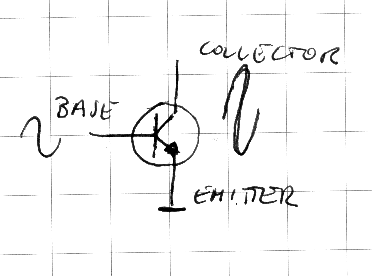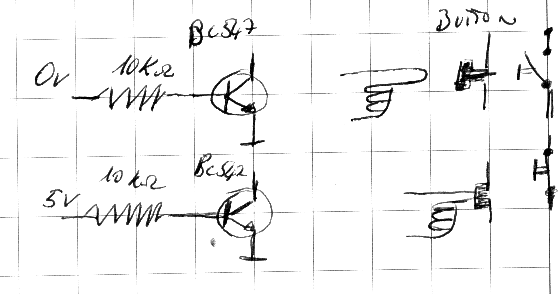Differenze tra le versioni di "No more secrets in your CPU: Part 1"
m |
m |
||
| Riga 13: | Riga 13: | ||
amplifier. The control pin is the base (B), the reference gate is the | amplifier. The control pin is the base (B), the reference gate is the | ||
emitter(E), the output gate is the collector(C). | emitter(E), the output gate is the collector(C). | ||
| + | |||
[[File:transistor.png]] | [[File:transistor.png]] | ||
| Riga 31: | Riga 32: | ||
When a current flows through the transistor's base the finger pushes the | When a current flows through the transistor's base the finger pushes the | ||
button, otherwise it keeps it released. | button, otherwise it keeps it released. | ||
| + | |||
[[File:transistorfinger.png]] | [[File:transistorfinger.png]] | ||
Versione delle 12:09, 14 mag 2014
This is the first of a set of postings. I am writing here, on my BLiki, the draft of a booklet about Computer Architecture in the spirit of "Making".
This booklet describes an educational tool created to reveal the secrets of the basic elements of digital computers. Nothing magic happens in the processor of you computers, it is just a matter of circuits an commutation of electric currents. Everything works using an elementary switching device: the transistor.
A transistor is an electronic component which is able to drive a high current on the basis of a low control current. It is basically an amplifier. The control pin is the base (B), the reference gate is the emitter(E), the output gate is the collector(C).
The low control current flowing between the base and the emitter, enables a high current between the collector and the emitter. For NPN transistors, the ones we use, these currents are positive (the potential, or voltage of the Base and Collector is higher than the potential of the Emitter). The symbol of a NPN transistor has the arrow of the emitter pointing outwards. There are other transistors named PNP, having the inwards arrow in their symbol. PNP transistors use negative currents instead of positive currents.
For our purposes we will use our transistors as binary switches. In fact a current of 0.5mA (almost) saturate a transistor of the type used in our experiemental tool (BC547). A transistor behaves like a remotely controlled finger pushing a button. When a current flows through the transistor's base the finger pushes the button, otherwise it keeps it released.

